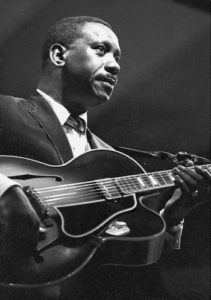
WesMontgomery
*This date marks Wes Montgomery’s birth in 1925. He was a Black jazz guitarist and one of the most influential postwar improvisers on his instrument.
John Leslie “Wes” Montgomery was from Indianapolis, Indiana. He began playing guitar in his late teens. He played in the Lionel Hampton band from 1948-50 and in Indianapolis during the 1950s, most often with his brothers Buddy (piano, vibes) and Monk (electric bass). In California in the late 1950s, he played with them in the Mastersounds and then as the Montgomery Brothers (1960-61).
Montgomery’s finest recordings include "The Incredible Jazz Guitar of Wes Montgomery, Movin’ Along, and Full House," from 1959-63. In the early 1960s, he played briefly in a John Coltrane group that never recorded. In 1964, recordings with string orchestra and big band accompaniments became best sellers, including Tequila, A Day in the Life, Bumpin, and California Dreamin. He led small groups in concerts and on international tours and worked in a quintet with his brothers for the rest of his life.
Inspired by late-swing guitarist Charlie Christian, Montgomery improvised with broken phrases and a bop-harmonic imagination. Instead of using a plectrum or fingers, he played guitar with the soft part of his thumb, resulting in a soft attack appropriate to his lyrical lines. He organized his solos by playing single-note melodies in initial choruses, octaves in middle choruses, and chords in climactic choruses.
His solo forms especially influenced later guitarists, most prominently George Benson. Montgomery died June 15, 1968, in Indianapolis.
Jazz People
by Harry N. Abrams, Incorporated, New York
Copyright 1976
ISBN 0-8109-1152-3